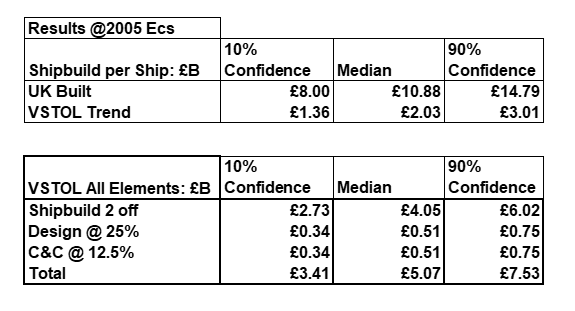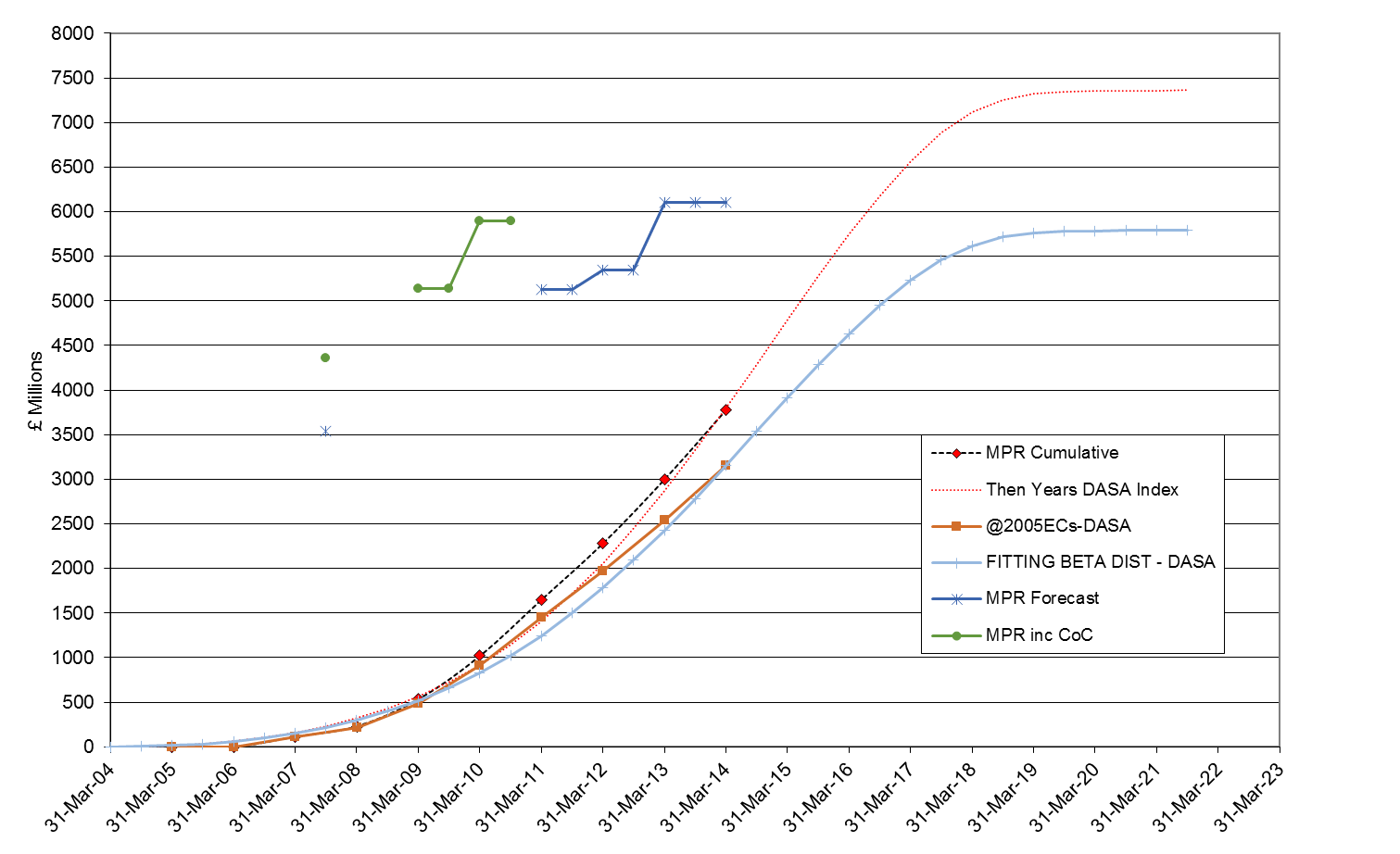Thanks to Brian Tanner for this guest blog
Independent Cost Analyst Brian Tanner discusses the prices being paid for the Royal Navy's Queen Elizabeth Carriers (QEC) Aircraft Carriers...
With the Queen Elizabeth Carriers more than half way through their construction programme and the press and NAO publications reporting significant cost growth, I thought it of interest to see where they lay on a historical trend line.
The first aircraft carrier built as such was HMS Argus, built by Beardmore, Glasgow after purchase by Admiralty in August 1916. She was to have been completed as Liner CONTE ROSSO for Lloyd Subuado of Italy but work had been suspended on outbreak of war in August 1914. The conversion was completed on 16th September 1918 at a cost of £1.308m (editors note: £1.308m in 1918 is equal to ~£70.7m in 2018).
HMS Argus was followed by HMS Hermes, designed and constructed as an aircraft carrier from the outset. Ordered from Armstrong's at Elswick in July 1917, work was suspended in September 1919 and in January 1920 the vessel was towed to HM Dockyard Devonport for completion. By the completion date in July 1923 it had been possible to take into account some of the lessons learnt during the conversion and reconstruction of HMS FURIOUS. One naval forum (NavWeaps Discussion Board) gives unattributed details of weight group breakdown and cost, viz: 10,075 t light; 10,417 t standard; 11,531 t normal; 12,423 t full load .Cost £1.203m.
HMS Eagle was converted from the partially built Chilean battleship Almirante Cochrane, a Dreadnought Battleship. All work on this ship ceased in 1914 and she lay on her slip until 1917 when her purchase by the Admiralty was negotiated with the Chilean Government, the purchase price being £1,334,358. Janes Fighting Ships 1939 states funds subsequently expended raised the total cost to £4,617,636 (editors note: ~£306.0m in 2018).
There was also the conversion of the three battle cruisers Courageous, Glorious and Furious in the interwar years. Referenced sources of cost on the internet show the total cost of each ship to be in excess of £4 million, a cost which when normalised exceeds that for subsequent vessels, no doubt due to the inclusion of costs for the original armament and structure.
Then there was HMS Ark Royal the Royal Navy’s first full-sized aircraft carrier and the first ship on which the hangars and flight deck were an integral part of the hull, instead of an add-on or part of the superstructure. Given that carrier construction until Ark Royal was mainly conversion or prolonged construction, it was decided to start the Historic Trend Analysis (HTA) from this carrier.
HMS Unicorn, an aircraft repair ship and light aircraft carrier, was ordered on 14 April 1939. Her construction was delayed several times in favour of higher priority projects and she was not completed until 12 March 1943. In order to accelerate the ship's completion, the Admiralty decided in 1942 that she would not be equipped with her full suite of maintenance and repair equipment. Excluding her armament, Unicorn cost £2,531,000.
In the years leading up to the Second World War the MoD began building the four ships of the Illustrious class of armoured fleet carrier. The design was developed into the two carriers of the Implacable class followed by the much larger Audacious class which became HMS Ark Royal and HMS Eagle, the last conventional fleet aircraft carriers to serve in the Royal Navy.
The 1942 Design Light Fleet Carriers, 10 of which were built, were designed and constructed by civilian shipyards to serve as an intermediate step between the expensive, full-size fleet aircraft carriers and the less expensive but limited-capability escort carriers.
The 1942 design was modified to take more modern aircraft and these ships became the Majestic-class. Six of the class were built but not completed until after the end of the war, most ended up being purchased by other navies.
The Centaur class of aircraft carriers of the Royal Navy was the last of the light fleet carrier designs started during the closing years of World War II, but construction was halted at the end of the war, four eventually being completed in the 1950s.
The Invincible class of light aircraft carrier entered service in the 1980s operating the VSTOL Sea Harrier. They lacked both the catapults and arrester gear needed in aircraft carriers to operate conventional jet aircraft and were therefore less complex.
Having precised the history of aircraft carriers in the Royal Navy there arises the question of cost. Typically any published or recorded cost can be presumed to be the shipbuilding cost – excluding armament/ electronics, but including the cost of main machinery even though that was at times the subject of a separate contract.
Cost data can come from various sources. Earlier aircraft carriers have costs given in Janes Fighting Ships of the period. Information on the carriers built during World War 2 is not immediately available
Following the end of the Second World War the estimated cost at completion for all Royal Navy vessels was reported in the Navy Estimates or predecessor publications. These have been compiled by Dstl Tim Jefferies and relevant costs have been used in this HTA.
A trend analysis can be done in Then Years monies in which case the trend includes inflation and any projection will be at the cost level of the date point used. For this HTA the intent was to forecast the cost of the Queen Elizabeth Class at 2005 levels to compare with decisions at that time.
Figure 1: Aircraft Carrier Reported Building Costs

Applying a geometric regression to the Royal Navy data produces a specific cost of £226 K/MT. Applying this to the public domain Full Load Displacement and an assumed Basic Weight: FLD ratio produces a unit shipbuilding cost of £10.9bn with a prediction interval of +33%, -25%.
But in effect useable data on carrier construction occurs at only two points in history so one is forcing a geometric curve through just two points. Questionable.
Also, the Short Take-Off and Vertical Landing (STOVL) carriers are simpler vessels, so perhaps the HTA is not appropriate. Instead, data on the build costs for first off STOVL carriers has been sources. These comprise two Italian carriers, a Thai carrier built in Spain and two US amphibious vessels with STOVL capability, i.e. LHD8 Makin Island and LHA6 America. Applying a geometric progression to these vessels produces a specific cost of £42K/MT with an 80% prediction interval of +50%, -33%. Applying this to the public domain Full Load Displacement and an assumed Basic Weight: FLD ratio produces a unit shipbuilding cost of £2.03bn.
The historical data relates to shipbuilding cost. To this must be added a design cost, assumed to be a typical value for large vessels of 20% to 25%, and an electronics and armaments cost assumed to be one eighth of the shipbuilding cost based on public domain information on LHA 6 USS America. Together these produce a total cost of £5.1bn at 2005 Economic Conditions (ECs).
The two trend lines are shown in this graph and the results are summarised in this table.
Figure 2: Historic Trend Chart at 2005 ECs
 Figure 3: Results at 2005 ECs
Figure 3: Results at 2005 ECs

How does this compare with current estimates?
Taking the expenditure reported in the Major Projects Reports (MPR) and normalising using the MoD Defence Inflation Estimates for Ships and Boats gives an expenditure at 31 March 2014 (latest figures) of £3.1bn at 2005 ECs.
Plotting the normalised expenditure and fitting S curves based on previous large ship expenditure profiles produces the follow graph:
Figure 4: HTA of QEC Aircraft Carriers

Any estimator has to be aware that extrapolation is dangerous, but the forecast from this exercise is £5.7bn at 2005 ECs. To produce a forecast cost at Outturn levels to accord with MPR data, estimated in year expenditure has been inflated using the average trend of the Defence Inflation Estimates for Ships & Boats of 2.5% per annum; this produces an estimate of £7.3bn, somewhat greater than the current MPR figure of £6.1bn.
The forecast of £5.8bn at 2005 ECs lies within the band forecast by the HTA.
